Today, John’s Intel Xeon Bronze 3204 benchmarks and review piece went live. I think he had some great insights, especially around the AVX-512 workloads on the chip, and other Intel Xeon Scalable processors. While reading through the piece, I wanted to take a quick moment and show a progression of CPUs in the ~$213 price band over the past seven years or six Intel Xeon generations.
Comparing 7 Years of Xeon Advancement at Around $213
We colloquially call the Intel Xeon Bronze 3204 and its predecessors in the $213 price range “light the platform” parts. That is because the primary purpose is to place the chips in a server solely to have the server power on, run PCIe and memory I/O, and offer basic x86 environments. By today’s standards, the compute performance is not great, but for a part that simply needs to be present to serve its function, it does not need to be great.
We are going to have a series of charts that show the evolution of the series from the Intel Xeon E5-2603 (Sandy Bridge) through the latest Intel Xeon Bronze 3204.
Light the Platform CPU Cores and Clocks
Focusing on a basic metric, cores and clock speeds shows a basic metric of how this segment is evolving. First, let us look at core counts.
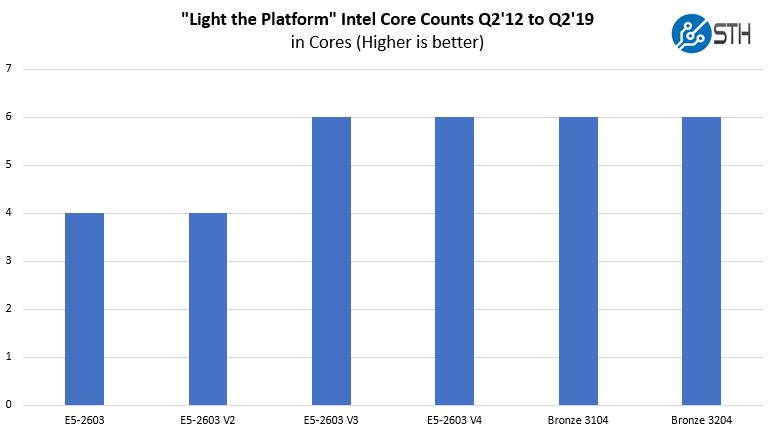
It has been about five years since the Intel Xeon E5-2603 V3 rocked this market with a 50% core count increase to six cores. Since Q3 2014, core counts in this segment have plateaued. Intel disables Hyper-Threading on these CPUs, so the number of cores is also the number of threads.
Next, we are going to look at clock speeds:
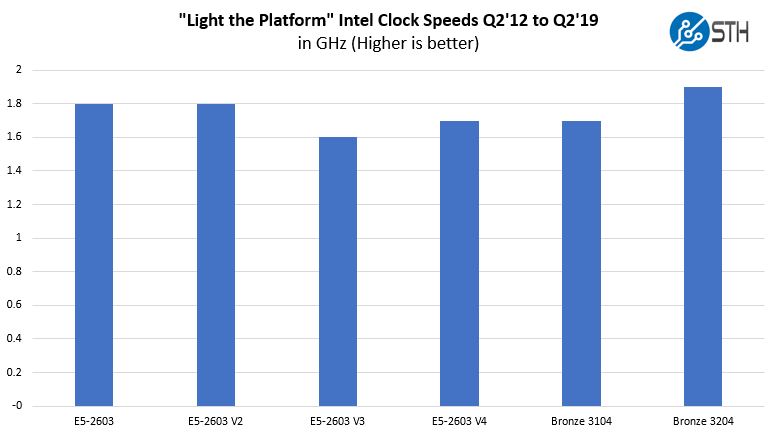
A mere 300MHz range separates the lowest clocked Intel Xeon E5-2603 V3 at 1.6GHz and the highest clocked, and newest, Intel Xeon Bronze 3204 at 1.9GHz. Intel disables Turbo Boost on these CPUs so what you see is what you get. There are applications and even functions (e.g. some network processing) that is single thread limited. Along with a low core count, clock speeds are modest in this segment.
Next, we are going to look at a derivative metric, cores multiplied by clock speeds.

This is not an exact performance picture. IPC from the Intel Xeon E5-2603 to the Intel Xeon Bronze 3104 went up well over 20% although Bronze 3104 to 3204 is a much smaller performance. Still, we wanted to show, at a basic level, how many execution cycles one gets simply looking at cores and clock speeds in the line. Here, we see a 6.8% CAGR over the last seven years and six generations. We get an 11.8% increase generation on generation (7 quarters between) from the Intel Xeon Bronze 3104 to Bronze 3204 due to the 1.7Ghz to 1.9GHz clock speed boost.
Simply put, there is very slow growth in performance we see in this segment.
Light the Platform Memory Capabilities
Some of the Intel Xeon Bronze market requires additional memory capacity so we wanted to look at what the memory picture looks like.
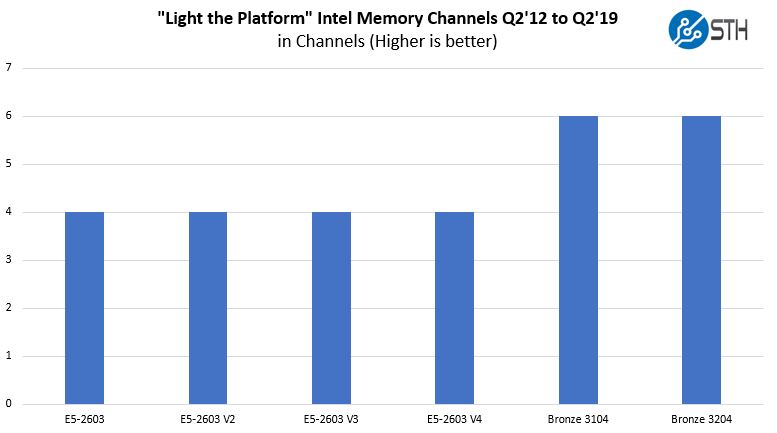
In both Intel Xeon E5 V1/ V2 as well as Xeon E5 V3/ V4 platforms, Intel stuck with a quad channel memory design. The majority of Intel Xeon Bronze servers ship without all memory channels populated, often shipping with one stick of DRAM which helps qualify the unit as a complete server for market share purposes.
Next, let us look at memory clocks.
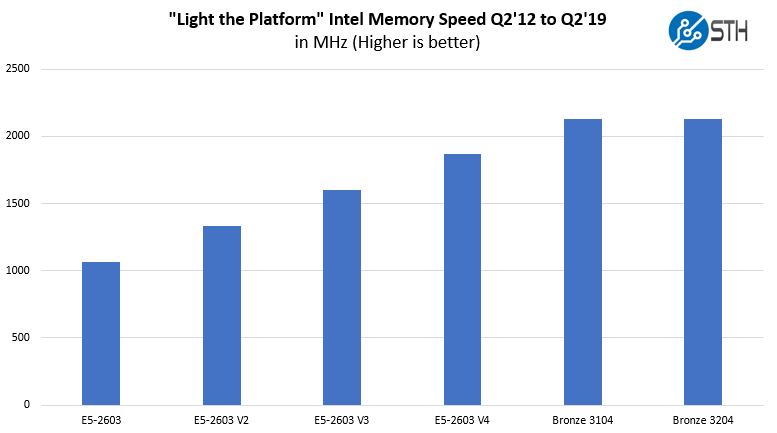
Every generation of Intel Xeon processors in recent history has been accompanied by faster DRAM. The 2nd Generation Intel Xeon Scalable Processor launch is no different with maximum clocks at the top-end migrating from DDR4-2666 to DDR4-2933. For the five previous generations, memory clocks have increased with successive generations. With this new Bronze 3204 launch, Intel kept memory clocks at DDR4-2133 speeds which is the same as the previous generation Intel Xeon Bronze 3104.
From the Intel Xeon E5 V1/ V2 to Xeon E5 V3/ V4 generations we saw the migration from DDR3 to DDR4 DRAM as well.
Perhaps the biggest change is in memory capacity which we will look at next.
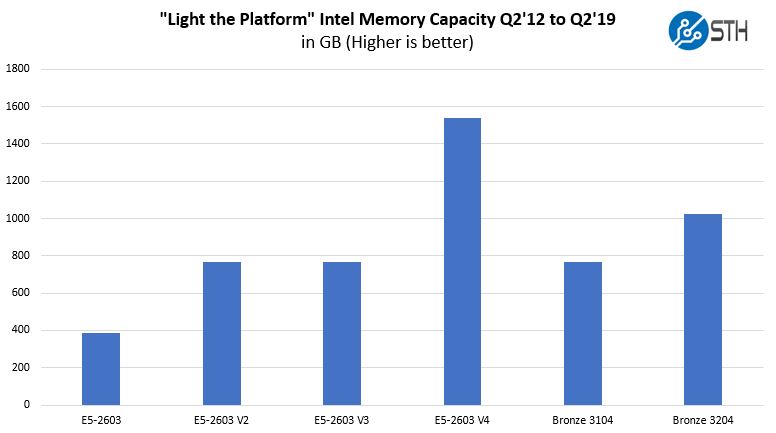
Here one can see memory capacity hit 1.5TB with the Intel Xeon E5-2603 V4 before falling to 768GB with the Intel Xeon Bronze 3104. The Intel Xeon Bronze 3204 brings this back to 1TB of memory capacity.
For any of our readers, if you are spending tens of thousands of dollars for 1TB of memory in a socket, get faster CPUs for a few hundred dollars more.
Light the Platform Additional Highlights
Since a primary function of the “light the platform” parts when they are deployed is to run PCIe devices, here is what the PCIe lane story looks like on a per-chip basis.
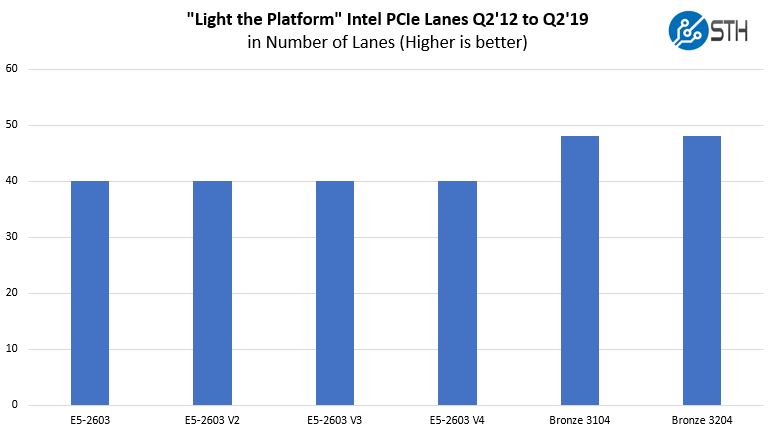
With the Intel Xeon Scalable launch, the PCIe lane count from the CPU hit 48 up from 40 in the previous four generations. Here, a single AMD EPYC 7251 provides more PCIe lanes than two of the Intel Xeon Bronze 3204 SKUs. AMD has heavily marketed its PCIe connectivity and will continue to do so with the AMD EPYC Rome generation. This is not just a “light the platform” feature, it is across the board for Intel’s CPUs making it a point ripe for competition. The 40 to 48 PCIe lane move over 7 years is a ~2.6% CAGR.
AMD with its next generation is moving to PCIe Gen4 in 2019 while Intel just released its mainstream parts with PCIe Gen3 for the sixth consecutive generation.
TDP has remained virtually constant.
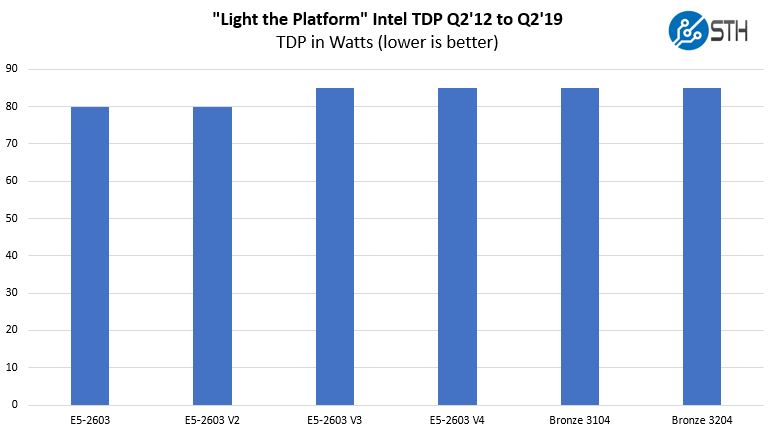
TDP does not equal power consumption. Instead, it is the thermal design power number or something that system designers need to take into account when designing cooling. This has moved from 80W to 85W but the measured power consumption is generally very low for parts depicted above.
Final Words
There is a dirty little secret with these CPUs that we gloss over often. We talked about it previously in AMD EPYC Market Share Gains in 2018 Our Take and our Channel Cobblers and a Hole in the AMD EPYC Line pieces. A server with an Intel Xeon Bronze 3204 CPU inside with a single DIMM counts as a unit shipped. That is important and something that is fairly well-known in the industry. If you take a look at the HPE ProLiant ML350 Gen10’s QuickSpecs there are six Pre-configured 2nd generation Intel Xeon Scalable models. Despite the ProLiant ML350 Gen10 (our review coming soon) being a dual socket server, two of those six pre-configured models have a single Intel Xeon Bronze 3204 CPU with a single DIMM installed.
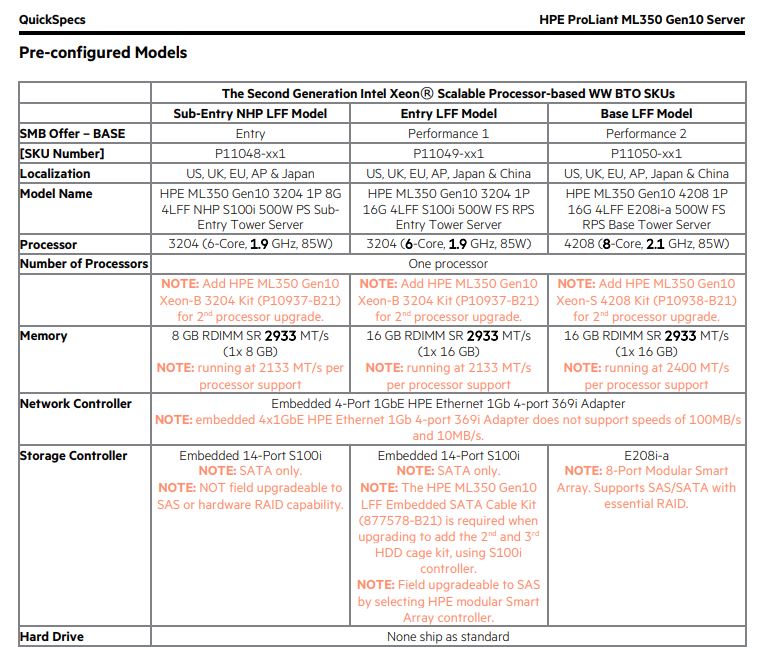
Sometimes these are just the lowest cost servers in a form factor. Quite often, channel partners use these to upgrade for their customers using the pre-configured models as the basis for configure-to-order systems.
Intel has been able to hold this price point, even as the socket and I/O has grown, which is impressive. At the same time, Intel is also setting the binning bar very low and this price point has largely been left out of the generational core and clock improvements we have seen elsewhere. Aside from our AVX-512 GROMACs findings, and new instructions like VNNI, this generation Xeon Bronze 3204 is a very minor upgrade over the previous generation. Clock speed increasing by 200MHz is the primary upgrade.
We hope you enjoyed some charts on the generational improvements. You can see John’s excellent Intel Xeon Bronze 3204 review for more on generational performance deltas.

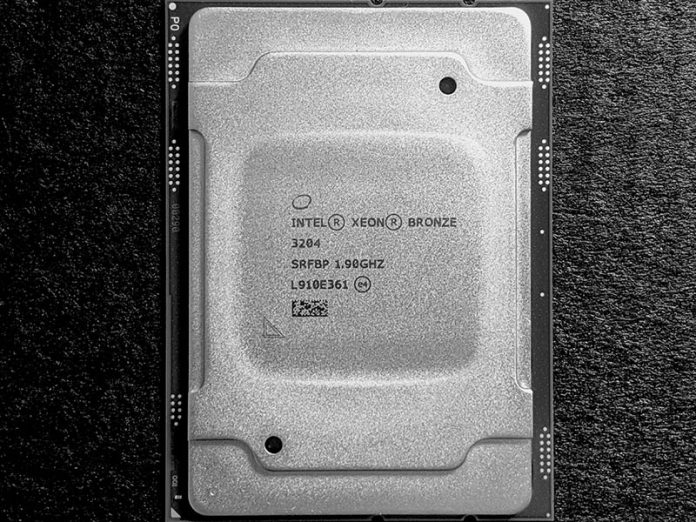



So we have to turn Hyperthreading off.
“Intel Recommends Disabling Hyper Threading”
More info on Tomshardware and mdsattacks dot com
Intel is making it easy to switch over to IBM, AMD or ARM